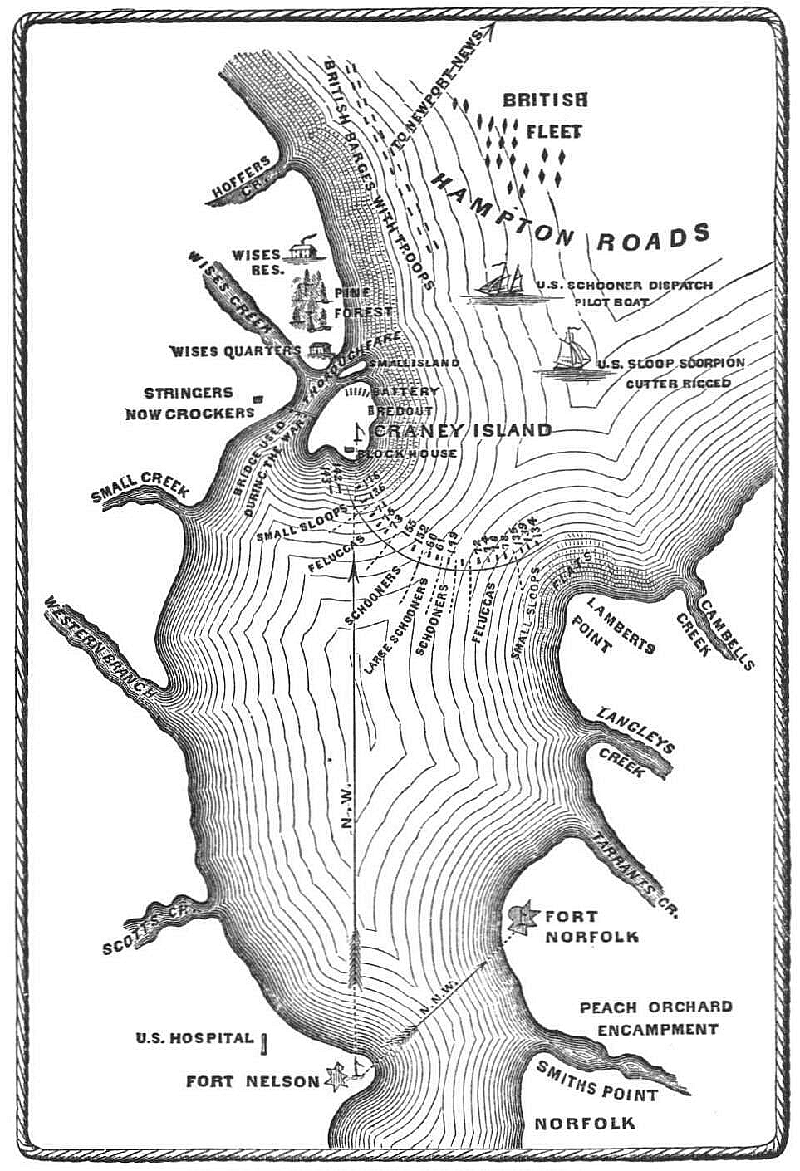
Fort Norfolk History - 1813
There was much work to be done at Fort Norfolk. In early March, federal and state military authorities reached an understanding. Taylor reported to Governor Barbour that he finally felt "justified in exercising authority without scruple, and of interfering internally in the internal arrangement of the Forts" (CVSP X:209). By March 6, Colonel Andrew J. McConnico of the Virginia militia had assumed, as the superior officer, the control of the Forts" and had "directed works to be constructed for the better defence of the reverse of Fort Norfolk." McConnico put 280 militiamen to work intrenching the approaches to the Borough" (CVSP X:195-196).
On February 20, 1813, the War Department had ordered Lieutenant Colonel Walker K. Armistead of the U.S. Army Corps of Engineers to "repair to Norfolk to make report on fortifications" (BC #395, War Dept. to Armistead, February 20, 1813). Armistead did not arrive until March 20 and was immediately taken on a tour of the harbor and the works underway in the rear of Fort Norfolk. "I carried him around," General Taylor said, "showed him what I had done, and developed what was still designed." Taylor reported to the governor that Armistead "expressed his approbation of my plans" (CVSP X:209).
The following day, Armistead informed Secretary of War John Armstrong that he proposed "to give Ft. Norfolk additional defense by running in its rear a line of Redoubts, answering as a barrier to the enemy should he attempt to double his attack by Land and Water." Armstrong replied that the engineer was to proceed with the plan (BC #402, Armistead to Armstrong, March 21, 1813; #404, Armstrong to Armistead, March 26, 1813). In mid-May, a fatigue party from the 4th Virginia Regiment was sent to "complete the works in the rear of Fort Norfolk" (Waggoner 1813-1814:23).
During the first two decades of the nineteenth century, Forts Nelson and Norfolk gradually exchanged places in the strategic thinking of those charged with defending the harbor. At the turn of the century, experts such as Rivardi, Latrobe, and Dearborn saw Fort Nelson as the central component to Norfolk's defense. Fort Norfolk was intended as a secondary work and was later dismissed as insignificant or untenable. In 1808, Armistead reconceived the defense of Norfolk and the inner harbor when he pointed out Fort Nelson's weakness and emphasized Fort Norfolk's potential. By the end of the War of 1812, the U.S. Army Corps of Engineers came to see Fort Norfolk as a small but nonetheless versatile position worthy of additional work. The engineers grew increasingly skeptical that Fort Nelson could ever be transformed into the impregnable guardian of the harbor that it was first envisioned to be.
On June 22, 1813, a British squadron attempted to storm the fortified position at Craney Island and gain entrance to Norfolk harbor. General Taylor's defenders repulsed the attack, inflicting heavy casualties and saving the Borough of Norfolk from possible destruction. In the spring of 1814, British activity on the eastern seaboard resumed, and Norfolk was again threatened. In April 1814, well over 3,000 Virginia militia troops were encamped at Norfolk harbor (CVSP X:313).
More History
Back, 1673, 1775, 1787, 1789, Army before 1793, 1793, 1794, More 1794, First Fort, 1795, 1796-1800, 1801-1806, 1807, 1808-1811, 1812, 1813, 1813-1814, 1816, 1817-1818, 1820-1821, 1824, 1835, 1842-1844, 1845, 1849, 1851, 1852, 1853, 1854, 1854 Keeper's House, 1854 Changes, 1858, 1859, 1861, 1862, 1863, 1864, 1875, 1884, 1893, 1903, 1923, Next
Source of Information
A CULTURAL RESOURCE MANAGEMENT PLAN OF FORT NORFOLK, NORFOLK, VIRGINIA prepared for U.S. Army Corps of Engineers, Norfolk District by the College Of WILLIAM & MARY, November 1995 under Contract No. DACW65-94-Q-0075.
David A. Clary's Fortress America: The Corps of Engineers, Hampton Roads, and United States Coastal Defense (1990)
William Bradshaw and Julian Tompkins's Fort Norfolk, Then and Now (n.d.).
The Norfolk Public Library vertical file of recent newspaper articles on Fort Norfolk. Including articles by James Melchor of the U.S. Army Corps of Engineers that describe archaeological and architectural findings on the fort property.
